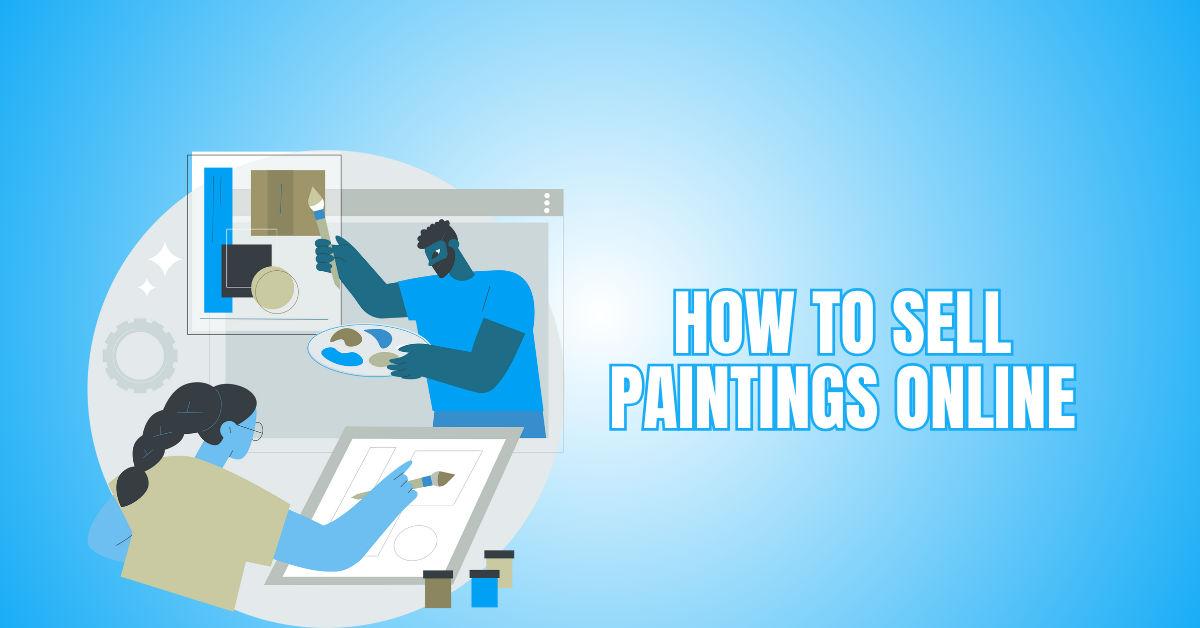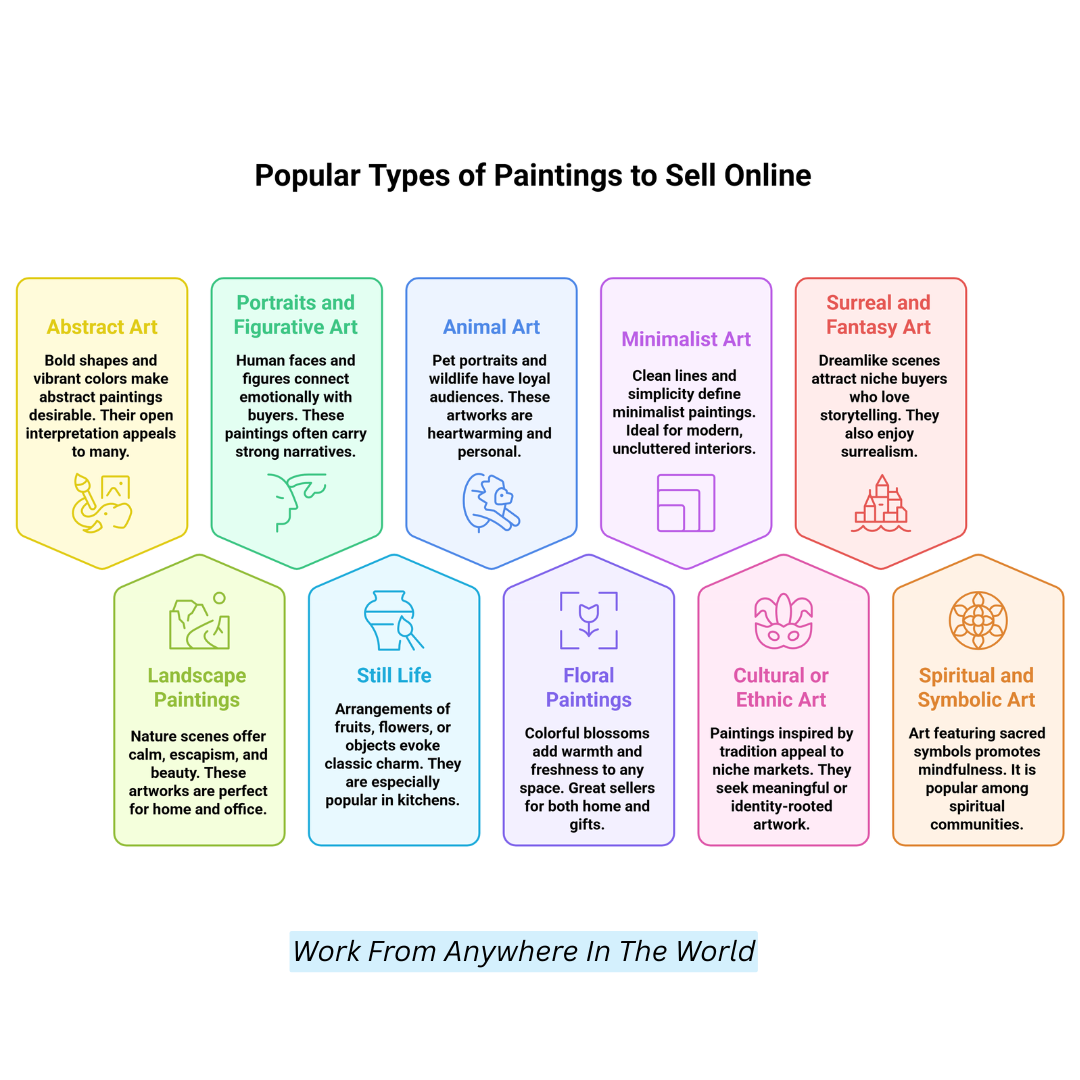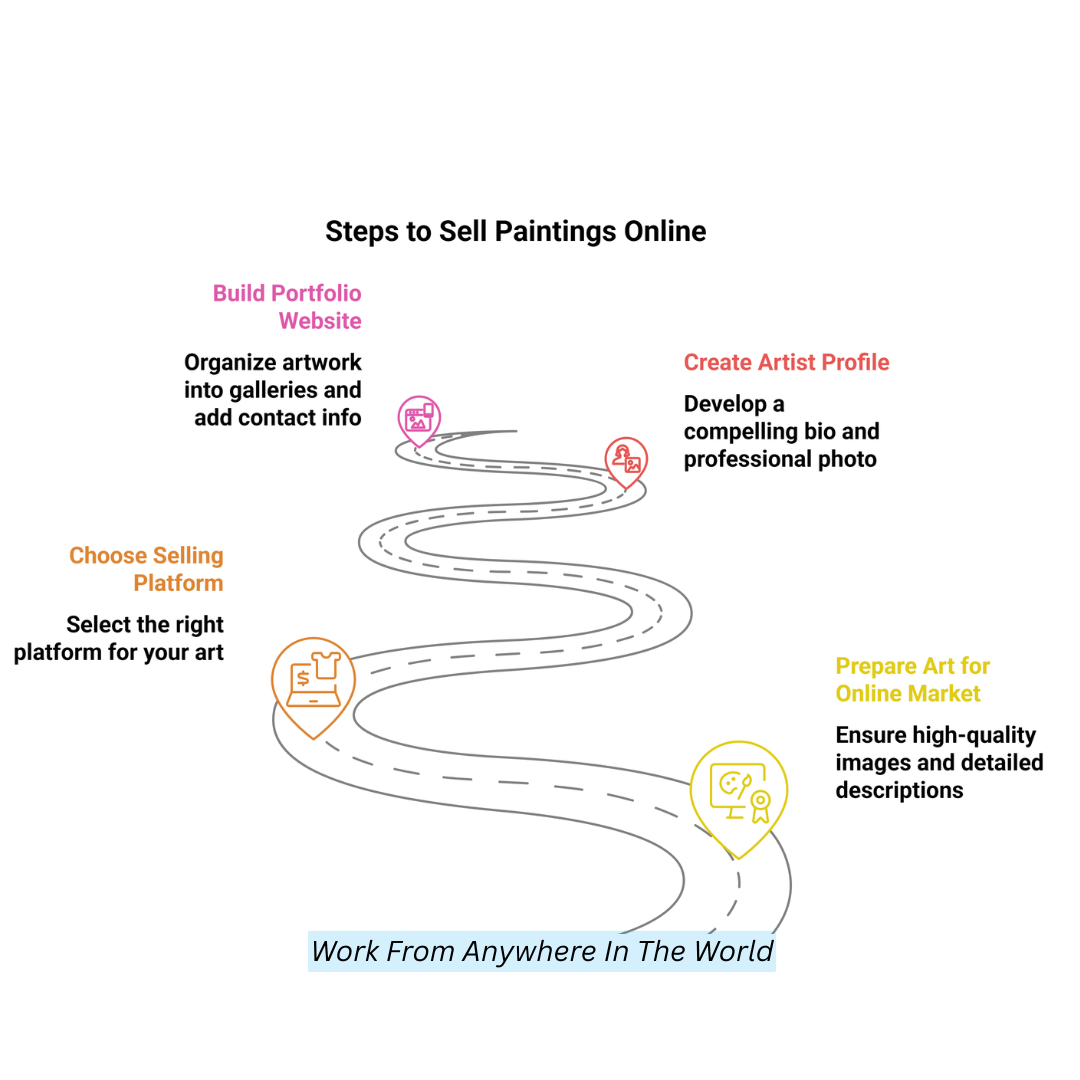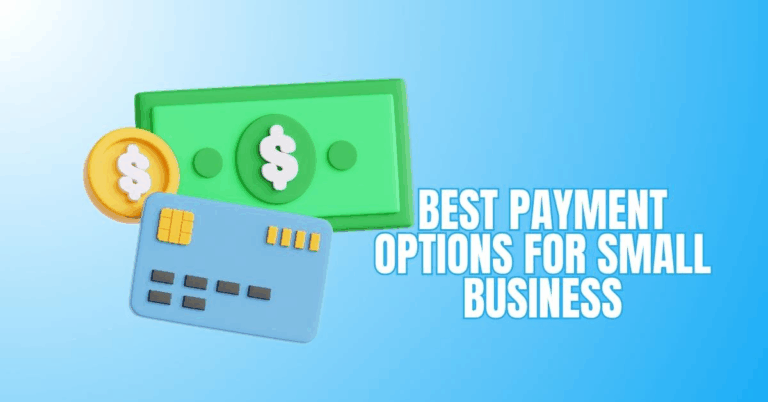How To Sell Paintings Online
How To Sell Paintings Online
Selling paintings online allows artists to reach a global audience, grow their brand, and earn income from their passion. You can turn your art into a successful online business with the right strategies—from choosing the best platforms to presenting your work professionally.
If you're wondering how to sell paintings online, this article will show you the steps you need to take to turn your artwork into a successful business.

Popular Types Of Paintings To Sell Online
Here are popular types of paintings that tend to sell well online:
1. Abstract Art
Bold shapes, vibrant colours and expressive strokes make abstract paintings highly desirable for modern homes. Their open interpretation appeals to a broad audience.
Estimated Price: $100–$1,000 depending on size and style.
2. Landscape Paintings
Nature scenes like mountains, beaches, and forests offer calm, escapism, and beauty. These artworks are perfect for home and office decor.
Estimated Price: $150–$2,000 based on realism and detail.
3. Portraits And Figurative Art
Human faces and figures connect emotionally with buyers. These paintings often carry strong narratives or personal stories, increasing their value.
Estimated Price: $200–$5,000 for custom or detailed portraits.
4. Still Life
Arrangements of fruits, flowers, or objects in still life evoke classic charm and elegance, especially popular in kitchens and dining rooms.
Estimated Price: $100–$800, depending on complexity and technique.
5. Animal Art
Pet portraits, wildlife, and farm animals have loyal audiences. These artworks are heartwarming and personal, especially among pet owners.
Estimated Price: $150–$1,500 depending on size and realism.
6. Floral Painting
Colourful blossoms or soft floral scenes add warmth and freshness to any space. Great sellers for both home and gift purposes.
Estimated Price: $80–$1,000 depending on detail and size.
7. Minimalist Art
Clean lines, muted tones, and simplicity define minimalist paintings. Ideal for modern, uncluttered interiors. They work well in small or large formats.
Estimated Price: $50–$500, depending on size and concept.
8. Cultural Or Ethnic Art
Paintings inspired by tradition, heritage, or folk elements appeal to niche markets seeking meaningful or identity-rooted artwork.
Estimated Price: $100–$2,000 based on authenticity and detail.
9. Surreal And Fantasy Art
Dreamlike, imaginative scenes with symbolic or fantastical elements attract niche buyers who love storytelling and surrealism.
Estimated Price: $200–$3,000 depending on complexity and originality.
10. Spiritual And Symbolic Art
Art featuring mandalas, chakras, or sacred symbols promotes mindfulness and serenity. Popular among spiritual communities.
Estimated Price: $80–$1,200 depending on intricacy and size.

Steps To Sell Paintings Online
Selling paintings online can be a rewarding way to reach art lovers worldwide. If you want to learn how to sell paintings online effectively, this step-by-step guide will help you easily navigate the process.
Here’s a simple step-by-step guide to help you start selling your artwork online successfully.
1. Prepare Your Art For The Online Market
High-Quality Images
Invest in proper lighting and a high-resolution camera to make your artwork stand out online. Natural daylight or soft, diffused light works best to avoid harsh shadows.
Want to Start Making Money Online?
Try My #1 Recommendation Program!
Capture images highlighting the piece's texture, fine details, and overall scale. Include close-ups and full views. A visually appealing presentation draws attention and builds trust with potential buyers, helping them appreciate the true quality of your work.
Detailed Descriptions
A strong description helps connect emotionally with buyers. Include the title, exact dimensions, medium (e.g., acrylic on canvas), and the story or inspiration behind the artwork.
Mention techniques used and what makes it unique. If framed, describe the framing style. Use engaging language to convey the piece’s essence. The more informative and vivid your description, the easier it is for buyers to understand and value your art.
Pricing Strategy
Pricing artwork fairly is essential to attract buyers while valuing your time and effort. Begin by researching prices of similar styles, sizes, and mediums of artworks.
Consider your experience level, the cost of materials used, and the hours invested in creating the piece. Also, account for listing platform fees and shipping.
Transparent, well-thought-out pricing signals professionalism and ensures you get compensated appropriately for your talent.
2. Choose The Right Selling Platform
Etsy
New artists can sell prints, small originals, or custom artwork on Etsy. The platform draws millions of shoppers searching for one-of-a-kind, handcrafted goods, and it's simple to set up.
With tools for promoting your listings, reviews to build trust, and low upfront costs, Etsy offers a great starting point.
Artists can also offer digital downloads and benefit from Etsy’s strong reputation in the handmade and art communities.
Saatchi Art
Saatchi Art is a top choice for fine artists aiming for a professional global reach. It handles marketing, international shipping, and customer service, allowing artists to focus on creating.
Want to Find Out How To Start Your Home-Based Business?
Try My #1 Recommendation Platform!
Artists are featured in curated collections and newsletters, gaining exposure to collectors worldwide. Saatchi takes a commission, providing high visibility and credibility in return. It’s especially suitable for artists selling high-end originals or limited-edition prints.
Shopify
Shopify allows artists to create their own branded online store with complete control over layout, pricing, and marketing.
Unlike marketplaces, it’s your storefront, offering a professional look and powerful tools like inventory tracking, SEO features, and integrations with social media.
You can customize the shopping experience and build direct customer relationships. Although it requires more setup and monthly fees, it’s an excellent long-term investment for serious art entrepreneurs.
Artfinder
Artfinder is a curated marketplace focused solely on original art from independent artists. Every artist must apply and be approved, ensuring quality and uniqueness on the platform.
It supports global shipping and offers features like artist profiles, customer reviews, and promotional tools. A strong art-focused community makes it excellent for painters seeking dedicated art buyers. Artfinder emphasizes sustainability and craftsmanship, aligning well with artists who value ethics and originality.
Instagram/Facebook
Facebook and Instagram are excellent platforms for growing your following and generating direct sales. Artists can showcase their creative process, connect with fans, and link directly to shops or accept commissions. With features like Instagram Shops and Facebook Marketplace, selling is more accessible than ever.
Are You Tired Of Scams?
Want to Start Making Money Online?
Social media also allows storytelling and personal engagement, which builds trust and loyalty. Consistent posting and interaction help grow your visibility and attract serious buyers.
3. Create A Compelling Artist Profile
Write An Authentic Biography
Understanding how to sell paintings online starts with crafting an authentic bio that connects buyers to your artistic journey and passion.
Include your background, education, and any exhibitions or awards. Focus on authenticity, not just achievements. Let buyers connect with the person behind the artwork.
A compelling bio builds trust, helps you stand out, and gives collectors insight into your passion, influences, and unique artistic voice.
Professional Profile Photo
A clear, friendly profile photo adds credibility and makes your online presence more relatable. People want to buy from real artists, not anonymous sellers.
Choose a high-quality headshot with good lighting and a neutral or creative background. Smile naturally or pose in your studio for authenticity.
A professional image helps create a positive first impression, supports branding, and strengthens your connection with potential collectors and clients.
Your Portfolio Or Website Link
Always include a link to your website or online portfolio to enable people to view your work. It centralizes your artistic presence and shows professionalism.
Your site should feature a gallery of your pieces, bio, contact info, and purchase options. This consistency fosters confidence and makes it simpler for potential customers to view and buy your artwork. Maintain it current and aesthetically consistent with your entire brand.
4. Build A Portfolio Website
Gallery Pages
Organizing your artwork into gallery pages by collection, medium, or theme helps visitors easily navigate your portfolio.
Clear categories make your site more user-friendly and showcase your versatility. For example, separate paintings, prints, sculptures, or group works by subject, like landscapes or abstracts.
This structure highlights your range and allows buyers to find what interests them quickly, improving their browsing experience and increasing the chance of a sale.
About Page
Your About page is where you share your personal story, artistic background, and what drives your creativity. It connects with visitors and humanizes your brand.
Add your training, inspirations, noteworthy accomplishments, and philosophy of art. By inviting collectors to learn about your background and the significance of your artwork, a well-written “About” page builds confidence and persuades them to purchase your artwork.
Contact Page
A dedicated Contact page is essential to make communication easy for buyers, galleries, or collaborators. Provide your company's phone number, email address, and social media links.
For convenience, you can also include a contact form. Clear contact options show you’re accessible and serious about your art career, which helps turn interest into actual sales or opportunities.
Shop Section
Integrate a Shop section using tools like WooCommerce or Shopify to sell your artwork directly from your website. These platforms offer secure payment gateways, inventory management, and customizable product pages.
A smooth, professional shopping experience encourages buyers to complete purchases. Offering prints, originals, or commissions with transparent pricing and shipping info boosts buyer confidence and helps you monetize your art effectively.

5. Market Your Art Through Social Media
Mastering how to sell paintings online involves using Instagram effectively by posting regularly, engaging authentically, and leveraging Stories and Reels to connect with potential buyers.
Engaging followers through comments, DMs, and polls builds a loyal community. Consistent, authentic interaction turns casual viewers into buyers.
Expand your audience and show off your personality in addition to your artwork by working with other artists and using pertinent hashtags.
Pinterest is ideal for driving evergreen traffic to your art portfolio or blog. You create a lasting online presence by pinning your artworks, tutorials, and related blog posts.
Pinterest is a fantastic way to draw in art enthusiasts year-round because its users frequently look for ideas and inspiration.
Organize your pins into themed boards to improve discoverability and direct traffic to your website or shop, increasing chances of sales and growing your audience.
Facebook Groups
Joining Facebook art-selling communities helps you connect with like-minded artists and potential buyers. These groups allow you to share your work, get criticism, and learn marketing tactics.
Active participation builds your reputation and expands your network. Many groups host sales events or art challenges that boost visibility.
Engaging genuinely in these communities can open doors to collaborations, commissions, and direct sales in a supportive environment.
TikTok
TikTok’s short-form videos are perfect for showcasing your artistic process through time-lapse videos, tutorials, or behind-the-scenes glimpses.
Creative, engaging content can quickly go viral, exposing your work to a vast audience. Authentic storytelling and trends help humanize your brand and attract younger art enthusiasts.
Want To Learn How To Create Your Own Website And Online Business?
Try My #1 Recommendation Training And Hosting Platform!
Use hashtags and well-known noises to improve discoverability, and reply to comments to develop a devoted, engaged audience that may become customers.
6. Offer Multiple Buying Options
Expand your offerings to attract different types of buyers:
Original Paintings
Original paintings are one-of-a-kind works of art that are frequently more expensive because of their rarity and the time required to create them.
Collectors value originals for their authenticity and the personal connection to the artist’s vision. Selling originals lets you showcase your best work and build a premium brand reputation.
These pieces often become focal points in collections or homes, making them highly desirable to serious art buyers.
Prints
Prints are affordable reproductions of your original artwork, making your art accessible to a broader audience. Using platforms like Printful or Fine Art America, you can offer high-quality prints without managing inventory or shipping.
Prints allow fans who love your style but can’t afford originals to own your work. This scalable option creates a steady income stream and helps increase your brand visibility by spreading your art to more homes.
Commissions
Commissions involve creating personalized artwork tailored to a client’s specific request or vision. This custom work often costs a premium due to the time and collaboration involved.
Offering commissions builds strong relationships with buyers and can lead to repeat clients or referrals. It also challenges your creativity by working with unique ideas, expanding your portfolio, and showcasing your ability to adapt your style to different tastes and needs.
7. Use SEO And Keywords To Get Discovered
To attract organic traffic, optimize your listings and website with keywords your target audience will likely search for. Search engine optimization (SEO) helps your artwork appear in Google searches, increasing visibility.
Use clear, descriptive titles like “Large Abstract Acrylic Painting on Canvas” and include relevant tags and categories to improve discoverability.
Naturally, incorporate keywords such as “minimalist watercolor landscape” or “modern oil painting” into your descriptions and blog posts.
Regularly update your site by sharing your creative process, exhibition stories, or inspiration. This consistent content engages visitors and boosts your search engine rankings, drawing in more art lovers.
8. Engage With Your Audience
Learning to sell paintings online includes building strong relationships with followers through active engagement and sharing exclusive previews to turn them into loyal collectors.
Share sneak peeks of new artwork to create excitement and interest for your audience. Running giveaways or promotions encourages participation and rewards your community, helping to grow your reach.
Additionally, asking for feedback or using polls invites your followers to be part of your creative process, making them feel valued and involved. These genuine interactions build trust and encourage long-term support for your art career.
9. Handle Logistics: Shipping And Packaging
Good packaging and shipping practices are essential to protect your artwork and leave a positive impression on buyers. Wrap your pieces carefully using bubble wrap and secure corners with cardboard to prevent damage during transit.
Choose sturdy, well-fitting boxes for extra protection. Including a certificate of authenticity and a personalized thank-you note adds a professional, thoughtful touch that buyers appreciate.
Always offer tracking and insurance options to provide peace of mind. If shipping internationally, familiarize yourself with regulations and costs to avoid delays or extra fees, ensuring a smooth delivery experience that strengthens your reputation as a reliable artist.

10. Set Up Secure Payment Methods
To ensure buyers can easily and safely make payments, offer multiple payment options such as major credit cards, PayPal, and Stripe.
These popular methods provide convenience and build trust. Implement secure checkout processes with SSL encryption to protect customers’ sensitive information and prevent fraud.
To prevent misunderstandings and boost customer confidence, be clear about your return and refund policies up front. Transparent policies make buyers feel more comfortable purchasing, knowing that their satisfaction is essential.
A seamless, safe payment process promotes recurring business and enhances your standing as a reliable vendor or artist.
11. Understand Legal Considerations
Protecting yourself and your artwork legally is crucial for a professional art business. Always use clear, written contracts for commissions that outline the scope, deadlines, payment terms, and usage rights to avoid misunderstandings.
Understand copyright laws to safeguard your intellectual property and know how others can legally use or reproduce your work.
Additionally, be aware of and comply with any taxes, business licenses, or permits required in your region. Proper legal protections secure your rights, build trust with clients and help you run your art career smoothly and responsibly.
12. Track Your Progress And Improve
Selling art online is an ongoing, evolving process that requires regular attention and adjustment. Track your website traffic and sales conversions to understand what attracts and converts visitors.
Use Etsy, Shopify, and social media analytics tools to gather valuable insights about your audience’s behaviour and preferences.
Experiment with different artistic styles, pricing strategies, and promotional methods to see what resonates best with buyers.
Always listen to customer feedback, using it to refine your approach. This continuous learning and adaptation help you grow your art business successfully.

Conclusion
You may convert your passion into a successful business and reach a worldwide audience by selling paintings online. Understanding how to sell paintings online effectively is key to achieving a wider audience, growing your brand, and turning your art into a successful business.
Remember, success takes time and consistency, so stay patient and refine your approach. With dedication and creativity, selling your art online can be rewarding and sustainable.
I trust you enjoyed this article about How To Sell Paintings Online. Please stay tuned for more articles. Take care!
JeannetteZ
Want to Learn How to Build Your Own Home-Based Online Business And Start Making Money Online From Your Comfortable Couch?
Try Wealthy Affiliate!
Your Opinion Is Important To Me
Do you have thoughts, ideas, or questions? I would love to hear from you. Please share your questions, experiences, remarks, and suggestions about How To Sell Paintings Online in the comments below. You can also email me at Jeannette@WorkFromAnywhereInTheWorld.com.
Disclosure
This post may contain affiliate links. I earn from qualifying purchases as an Amazon Associate and through other affiliate programs. Please read my full affiliate disclosure.
You may also enjoy the following articles:
Wealthy Affiliate Coupons For Premium Memberships
Wealthy Affiliate Review – Scam or Legit? The Truth Exposed
An Insider Wealthy Affiliate Review
How To Do Social Media Giveaways
How To Sell Homemade Food Online







